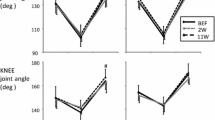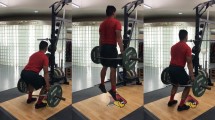Abstract
Purpose
To examine changes to neuromuscular control of leg stiffness following 42 min of soccer-specific exercise.
Methods
Ten youth soccer players, aged 15.8 ± 0.4 years, stature 1.73 ± 0.06 m and mass 59.8 ± 9.7 kg, hopped on a force plate at a self-selected frequency before and after simulated soccer exercise performed on a non-motorised treadmill. During hopping, muscle activity was measured using surface electromyography from four lower limb muscles and analysed to determine feedforward- and feedback-mediated activity, as well as co-contraction.
Results
There was a small, non-significant change in stiffness following exercise (26.6 ± 10.6 vs. 24.0 ± 7.0 kN m−1, p > 0.05, ES = 0.25), with half the group increasing and half decreasing their stiffness. Changes in stiffness were significantly related to changes in centre of mass (CoM) displacement (r = 0.90, p < 0.01, extremely large correlation) but not changes in peak ground reaction force (r = 0.58, p > 0.05, large correlation). A number of significant relationships were observed between changes in stiffness and CoM displacement with changes in feedforward, feedback and eccentric muscle activity of the soleus and vastus lateralis muscles following exercise (r = 0.64–0.98, p < 0.05, large–extremely large correlations), but not with changes in co-contraction (r = 0.11–0.55, p > 0.05, small–large correlations).
Conclusions
Following soccer-specific exercise individual changes in feedforward- and reflex-mediated activity of the soleus and vastus lateralis, and not co-contraction around the knee and ankle, modulate changes in CoM displacement and leg stiffness.


Similar content being viewed by others
Abbreviations
- ANOVA:
-
Analysis of variance
- BF:
-
Biceps femoris
- BGA:
-
Background muscle activity
- CoM:
-
Centre of mass
- EMG:
-
Electromyography
- HR:
-
Heart rate
- M 1 :
-
Short-latency stretch reflex
- M 2 :
-
Medium-latency stretch reflex
- M 3 :
-
Long-latency stretch reflex
- GRF:
-
Ground reaction force
- SSIET:
-
Soccer-specific intermittent exercise test
- SOL:
-
Soleus
- TA:
-
Tibialis anterior
- VL:
-
Vastus lateralis
References
Alentorn-Geli E, Myer GD, Silvers HJ, Samitier G, Romero D, Lazaro-Haro C, Cugat R (2009) Prevention of non-contact anterior cruciate ligament injuries in soccer players. Part 1: mechanisms of injury and underlying risk factors. Knee Surg Sports Traumatol Arthrosc 17:705–729
Andersson H, Raastad T, Nilsson J, Paulsen G, Garthe I, Kadi F (2008) Neuromuscular fatigue and recovery in elite female soccer: effects of active recovery. Med Sci Sports Exerc 40:372–380
Avela J, Komi PV (1998) Reduced stretch reflex sensitivity and muscle stiffness after long-lasting stretch-shortening cycle exercise in humans. Eur J Appl Physiol Occup Physiol 78:403–410
Bouffard M, Reid G (2012) The good, the bad, and the ugly of evidence-based practice. Adapt Phys Activ Q 29:1–24
Brughelli M, Cronin J (2008) Influence of running velocity on vertical, leg and joint stiffness : modelling and recommendations for future research. Sports Med 38:647–657
Butler RJ, Crowell HP 3rd, Davis IM (2003) Lower extremity stiffness: implications for performance and injury. Clin Biomech (Bristol, Avon) 18:511–517
Cloke D, Moore O, Shah T, Rushton S, Shirley MD, Deehan DJ (2012) Thigh muscle injuries in youth soccer: predictors of recovery. Am J Sports Med 40:433–439
Cone JR, Berry NT, Goldfarb AH, Henson RA, Schmitz RJ, Wideman L, Shultz SJ (2012) Effects of an individualized soccer match simulation on vertical stiffness and impedance. J Strength Cond Res 26:2027–2036
Dutto DJ, Smith GA (2002) Changes in spring-mass characteristics during treadmill running to exhaustion. Med Sci Sports Exerc 34:1324–1331
Edwards AM, Macfadyen AM, Clark N (2003) Test performance indicators from a single soccer specific fitness test differentiate between highly trained and recreationally active soccer players. J Sports Med Phys Fit 43:14–20
Ekstrand J, Hagglund M, Walden M (2011) Injury incidence and injury patterns in professional football: the UEFA injury study. Br J Sports Med 45:553–558
Emery CA, Meeuwisse WH (2006) Risk factors for injury in indoor compared with outdoor adolescent soccer. Am J Sports Med 34:1636–1642
Farley CT, Morgenroth DC (1999) Leg stiffness primarily depends on ankle stiffness during human hopping. J Biomech 32:267–273
Hawkins RD, Hulse MA, Wilkinson C, Hodson A, Gibson M (2001) The association football medical research programme: an audit of injuries in professional football. Br J Sports Med 35:43–47
Hewett TE, Zazulak BT, Myer GD, Ford KR (2005) A review of electromyographic activation levels, timing differences, and increased anterior cruciate ligament injury incidence in female athletes. Br J Sports Med 39:347–350
Hobara H, Kanosue K, Suzuki S (2007) Changes in muscle activity with increase in leg stiffness during hopping. Neurosci Lett 418:55–59
Hobara H, Kimura K, Omuro K, Gomi K, Muraoka T, Iso S, Kanosue K (2008) Determinants of difference in leg stiffness between endurance- and power-trained athletes. J Biomech 41:506–514
Hopkins WG, Marshall SW, Batterham AM, Hanin J (2009) Progressive statistics for studies in sports medicine and exercise science. Med Sci Sports Exerc 41:3–13
Horita T, Komi PV, Nicol C, Kyrolainen H (1999) Effect of exhausting stretch-shortening cycle exercise on the time course of mechanical behaviour in the drop jump: possible role of muscle damage. Eur J Appl Physiol Occup Physiol 79:160–167
Hughes G, Watkins J (2006) A risk-factor model for anterior cruciate ligament injury. Sports Med 36:411–428
Hunter I, Smith GA (2007) Preferred and optimal stride frequency, stiffness and economy: changes with fatigue during a 1-h high-intensity run. Eur J Appl Physiol 100:653–661
Kofotolis ND, Kellis E, Vlachopoulos SP (2007) Ankle sprain injuries and risk factors in amateur soccer players during a 2-year period. Am J Sports Med 35:458–466
Komi PV (2000) Stretch-shortening cycle: a powerful model to study normal and fatigued muscle. J Biomech 33:1197–1206
Koutures CG, Gregory AJ (2010) Injuries in youth soccer. Pediatrics 125:410–414
Kuitunen S, Ogiso K, Komi PV (2011) Leg and joint stiffness in human hopping. Scand J Med Sci Sports 21:e159–e167
Lakomy HK (1987) The use of a non-motorised treadmill for analysing sprint performance. Ergonomics 30:627–637
Lloyd RS, Oliver JL, Hughes MG, Williams CA (2012) Age-related differences in the neural regulation of stretch-shortening cycle activities in male youths during maximal and sub-maximal hopping. J Electromyogr Kinesiol 22:37–43
McLean SG, Fellin RE, Suedekum N, Calabrese G, Passerallo A, Joy S (2007) Impact of fatigue on gender-based high-risk landing strategies. Med Sci Sports Exerc 39:502–514
Millet GY, Lepers R (2004) Alterations of neuromuscular function after prolonged running, cycling and skiing exercises. Sports Med 34:105–116
Mohr M, Krustrup P, Bangsbo J (2003) Match performance of high-standard soccer players with special reference to development of fatigue. J Sports Sci 21:519–528
Nicol C, Avela J, Komi PV (2006) The stretch-shortening cycle: a model to study naturally occurring neuromuscular fatigue. Sports Med 36:977–999
Oliver JL, Smith PM (2010) Neural control of leg stiffness during hopping in boys and men. J Electromyogr Kinesiol 20:973–979
Oliver J, Armstrong N, Williams CA (2007) Reliability and validity of a soccer-specific test of prolonged repeated sprint ability. Int J Sports Physiol Perform 2:137–149
Oliver J, Armstrong N, Williams C (2008) Changes in jump performance and muscle activity following soccer-specific exercise. J Sports Sci 26:141–148
Paavolainen L, Nummela A, Rusko H, Hakkinen K (1999) Neuromuscular characteristics and fatigue during 10 km running. Int J Sports Med 20:516–521
Padua DA, Carcia CR, Arnold BL, Granata KP (2005) Gender differences in leg stiffness and stiffness recruitment strategy during two-legged hopping. J Mot Behav 37:111–125
Price RJ, Hawkins RD, Hulse MA, Hodson A (2004) The Football Association medical research programme: an audit of injuries in academy youth football. Br J Sports Med 38:466–471
Voigt M, Dyhre-Poulsen P, Simonsen EB (1998) Modulation of short latency stretch reflexes during human hopping. Acta Physiol Scand 163:181–194
Wilson JM, Flanagan EP (2008) The role of elastic energy in activities with high force and power requirements: a brief review. J Strength Cond Res 22:1705–1715
Conflict of interest
None.
Author information
Authors and Affiliations
Corresponding author
Additional information
Communicated by Peter Krustrup.
Rights and permissions
About this article
Cite this article
Oliver, J.L., De Ste Croix, M.B.A., Lloyd, R.S. et al. Altered neuromuscular control of leg stiffness following soccer-specific exercise. Eur J Appl Physiol 114, 2241–2249 (2014). https://doi.org/10.1007/s00421-014-2949-z
Received:
Accepted:
Published:
Issue Date:
DOI: https://doi.org/10.1007/s00421-014-2949-z




